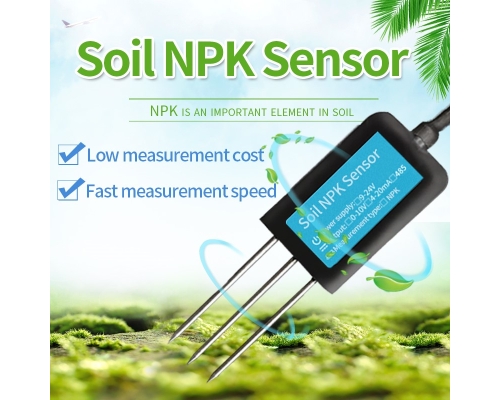The global agricultural landscape is undergoing a paradigm shift driven by technological advancements aimed at addressing pressing challenges such as climate change, population growth, and resource scarcity. Among these innovations, soil sensors have emerged as a game-changer, reshaping how farmers manage crops, optimize resource use, and enhance productivity. By providing real-time data on soil health, moisture levels, nutrient content, and environmental conditions, these sensors enable precision agriculture—a farming approach that tailors inputs to specific field needs, reducing waste and maximizing efficiency.

The Evolution of Soil Sensors
Soil sensors have evolved significantly since their inception. Early iterations relied on basic moisture meters or probes that offered limited insights into soil conditions. Today, modern soil sensors integrate advanced technologies such as IoT (Internet of Things), AI (Artificial Intelligence), and machine learning to deliver hyper-localized, actionable data. These sensors can be deployed at various depths within the soil profile, monitoring parameters like temperature, electrical conductivity (EC), pH, and even microbial activity.
The proliferation of low-cost, durable sensors has democratized access to precision agriculture tools, empowering smallholder farmers alongside large-scale agribusinesses. This accessibility is crucial in regions where food security is threatened by unpredictable weather patterns and degraded soils.
Real-Time Data: The Backbone of Precision Agriculture
The cornerstone of soil sensors’ impact lies in their ability to generate real-time data. Traditional farming practices often rely on periodic soil sampling or generalized weather forecasts, which can lead to suboptimal decision-making. For instance, over-irrigating crops not only wastes water but can also leach nutrients from the soil, harming plant health and the environment. Conversely, under-irrigating may stress crops, reducing yields and quality.
Real-time soil sensor data enables farmers to:
Optimize Irrigation: Sensors can trigger automated irrigation systems when soil moisture levels drop below a threshold, ensuring plants receive water precisely when needed. This reduces water consumption by up to 50% in some cases, as seen in regions like California’s Central Valley, where drought-stricken farms have adopted sensor-driven irrigation.
Tailor Fertilizer Application: By monitoring nutrient levels (e.g., nitrogen, phosphorus, potassium), sensors help farmers apply fertilizers only where and when they are required. This minimizes runoff and pollution while lowering input costs. A study by the University of Nebraska-Lincoln found that variable-rate fertilization based on sensor data increased corn yields by 8–12% compared to uniform application.
Prevent Pest and Disease Outbreaks: Changes in soil moisture and temperature can influence pest populations and disease susceptibility. Early warnings from sensors allow farmers to implement targeted interventions, reducing the need for blanket pesticide applications.
Enhance Soil Health: Continuous monitoring of parameters like organic matter content and compaction helps farmers adopt regenerative practices such as cover cropping or reduced tillage, which improve soil structure and fertility over time.
Case Studies: Real-World Impact
The transformative potential of soil sensors is evident in numerous real-world applications. In Australia, where water scarcity is a perennial challenge, farmers have deployed soil moisture sensors to manage irrigation in vineyards and orchards. By synchronizing watering schedules with crop water needs, growers have achieved higher fruit quality while conserving precious water resources.
In the Netherlands, a global leader in precision agriculture, soil sensors are integral to the country’s ambition to double agricultural production by 2050 without expanding farmland. Dutch farmers use sensor networks to monitor greenhouse gas emissions and nutrient cycling, aligning practices with climate-smart agriculture goals.
Emerging economies are also leveraging soil sensors. In India, where smallholder farmers struggle with erratic monsoons, startups like Fasal are providing affordable sensor kits that connect to smartphones, offering localized crop advisories. Early adopters have reported yield increases of 15–20% and reduced input costs by 30%.
Challenges and Opportunities
Despite their promise, soil sensors face hurdles to widespread adoption. Key challenges include:
Data Management: The sheer volume of data generated by sensor networks can overwhelm farmers, especially those lacking digital literacy. Solutions lie in user-friendly interfaces and AI-driven analytics that translate raw data into actionable insights.
Cost: While sensor prices have fallen, upfront investment remains a barrier for some farmers. Public-private partnerships and subsidy programs can accelerate adoption in underserved regions.
Interoperability: Ensuring seamless integration of sensors with existing farm management systems (e.g., tractors, drones) requires standardized communication protocols and open-source platforms.
Cybersecurity: As agricultural data becomes digitized, protecting it from breaches is critical to maintaining farmer trust and operational continuity.
However, these challenges also present opportunities. For instance, startups are developing subscription-based sensor services that eliminate upfront costs, while governments are investing in rural broadband infrastructure to improve connectivity. Collaborations between tech companies, academia, and farmers’ cooperatives are fostering innovation in sensor design and data analytics.
The Future of Soil Sensors
Looking ahead, soil sensors are poised to become even more sophisticated. Advances in nanotechnology could lead to sensors that are smaller, cheaper, and capable of detecting multiple parameters simultaneously. Integration with satellite imagery and weather forecasts will enable predictive analytics, allowing farmers to anticipate and mitigate risks before they occur.
Moreover, the role of soil sensors extends beyond farming. In urban agriculture, they can optimize rooftop gardens and vertical farms, while in environmental restoration projects, they monitor soil health in reclaimed mine sites or degraded ecosystems.
Conclusion
Soil sensors represent a pivotal innovation in the quest for sustainable, resilient agriculture. By providing real-time, hyper-localized data, they empower farmers to make informed decisions that enhance productivity, conserve resources, and protect the environment. As technology continues to evolve and costs decline, the adoption of soil sensors will likely accelerate, driving a global shift toward precision agriculture. This transformation is not merely about increasing yields—it is about nurturing a future where farming nourishes both people and the planet. The revolution has begun, and the soil is listening.
This article highlights the transformative role of soil sensors in modern agriculture, emphasizing their technical evolution, real-world applications, and future potential. By addressing both challenges and opportunities, it underscores the importance of collaborative efforts to realize the full benefits of this technology.